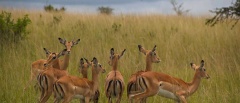Akagera National Park
A national park made of a diversity of ecosystems
Located in the north east of Rwanda, Akagera is known as one of Rwanda’s oldest national parks. Although Akagera is a relatively small park (approximately 900 km2), it is made up of a variety of different ecosystems, from swamps, mountains and open plains. Its diverse topography offers breath-taking views and unique experiences to the few visitors that travel there.
Located in the north east of Rwanda, Akagera is known as one of Rwanda’s oldest national parks. Although Akagera is a relatively small park (approximately 900 km2), it is made up of a variety of different ecosystems, from swamps, mountains and open plains. Its diverse topography offers breath-taking views and unique experiences to the few visitors that travel there.
Akagera National Park is approximately a two-hour drive from Rwanda’s capital, Kigali, so visits to the park can be done in a day trip. Akagera’s open plains are home to a range of wildlife including elephants, giraffe, buffalo, zebra and a variety of antelope species. In 2015, seven lions were released into the park, fitted with satellite colours to allow the park management to track their movements as they explored their new surroundings. Since then, the lion population has slowly increased which shows positive progression in the park.
Further from the plains, the Akagera River on the eastern boundary feeds into a number of lakes which makes an area of swamps and wetlands. Hippos and crocodiles can be seen on the river banks and for those interested in birds, this is a great place to see a variety of species that are endemic to this park only.
Although there is wildlife in Akagera, other national parks in East Africa definitely present a better opportunity for game viewing. For example, the Serengeti National Park in northern Tanzania offers an impressive safari experience alongside opportunity to see the Great Migration as they circulate the plains of the enormous park.


